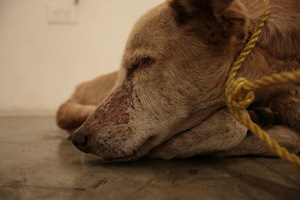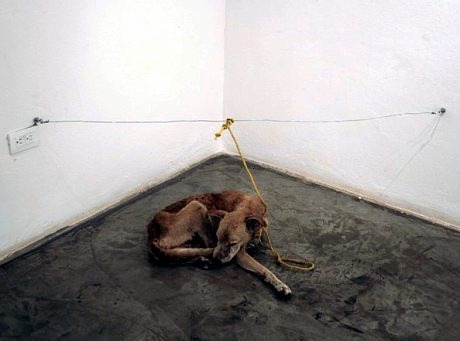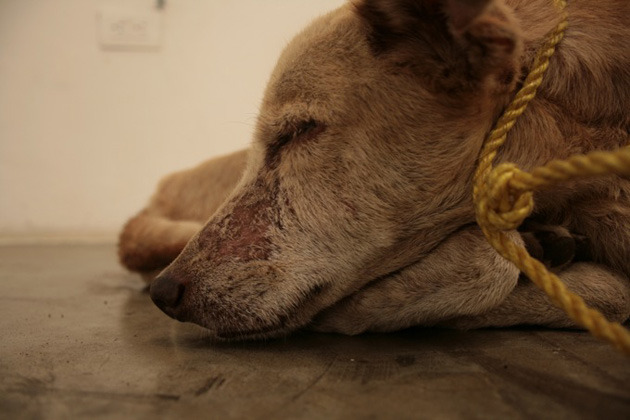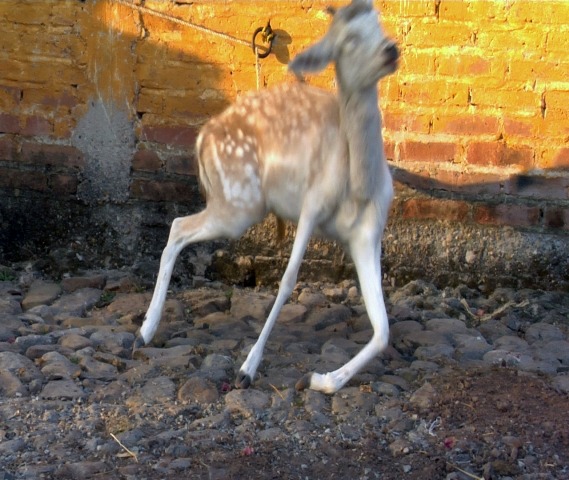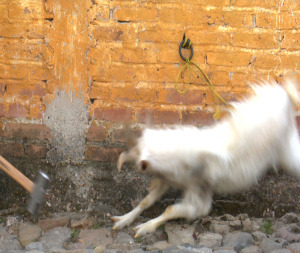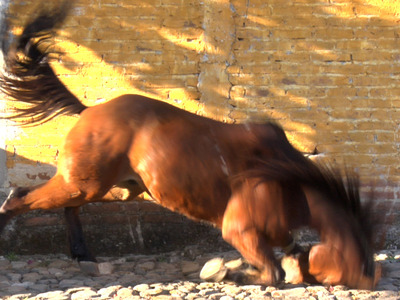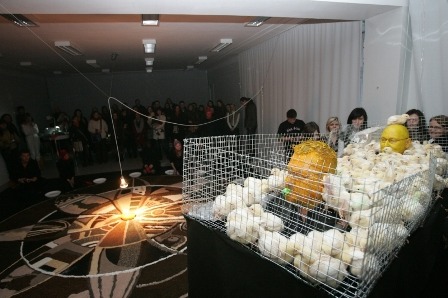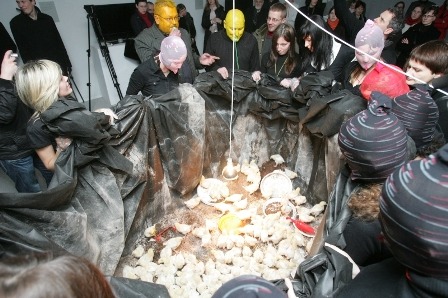VICTIMS OF CONTEMPORARY ART 0
(Helpless animals – meat of contemporary art cannons?) Kotryna Džilavjanaitė
www.kamane.lt, 2008 04 27
Guillermo Vargas, “Eres lo que lees” (“You are what you read”)
Adel Abdessemed, “Don’t trust me”
Robertas Antinis and Česlovas Lukenskas, performance
In brief: Year 1962, Vienna. The Austrian artist and representative of Vienna action movement Herman Nitsch closed himself in a cellar with two assistants and crucified a butchered lamb, then he was crucified himself and washed with the animal’s blood. Even though H.Nitsch was constantly chased by law representatives, he was imprisoned for sacrileges, he is now deemed one of the most important figures of post-modernism and has been working as a visiting professor in many higher art schools from the ninth decade.
Year 2001. Toronto. The student of Ontario Art and Design College Jesse Power and two like-minded people Anthony Wennekers and Matt Kaczorowski caught a cat, tortured it to death, peeled the skin off and gutted the animal. The process was filmed as a video work for which J. Power was evaluated by the highest mark at college. J.Power stated that the film was an artistic protest against the use of animals in food industry.
Year 2006, Vilnius. The Lithuanian artist Evaldas Jansas participated in the international festival of performances “Dimension 1” at the Contemporary Art Centre, where he intended to cut the head of a live lamb. The action called “Prevention of World Democracy” was stopped by the Lithuanian Association of Animals Custody, the police and the State Food and Veterinary Service.
Year 2007, Managua. The artist of Costa Rica Guillermo Vargas organised an exhibition-installation at Managua cultural centre in Nicaragua city. The main material was the homeless dog Natividad, which was tied by G. Vargas in the gallery space and the artist prohibited to feed it and give water to it. The wall at which the dog lied was glued with dry food for dogs which the dog could not reach. It was a protest against indifference of people regarding homeless animals. The actions of G.Vargas received great resentment of the public and the dog was set free.
Year 2008. San Francisco. The artist of Algeria Adel Abdessemed created a video work “Don’t Trust Me” in which it was filmed how a sheep, pig, horse, goat and fawn was beaten to death by a hammer. The work was exhibited at San Francisco art institute. It was stated that the artist emphasised disobedience regarding religious, cultural and moral taboos. After organisations protecting animals’ rights intervened, the work was excluded from the exhibition.
Year 2008, Kaunas. The members of the Lithuanian artists’ group Post Ars Robertas Antinis and Česlovas Lukenskas presented a performance at Vytautas Magnus University gallery 101 in which two hundred chickens were used. There were no conscious intentions to harm the chickens in the performance but discontent of the audience was caused by the irreverent behaviour with birds – they were transported in a small box, appeared in a stuffy room and were poured into one pile with other materials used in the event after the performance. In the artists’ opinion, the reaction of the public was hyperbolised.
It is evident that the variant of Kaunas creators of using animals in creation differs from the radical exploitation of life in artworks described above. Still, the performance of Post Ars members caused a big riot and controversial disputes regarding the relation of artists with animals as a means of self-expression. The art action was reviewed in articles, in internet browsers’ comments and in the discussion organised at the gallery. However, less attention was paid to the performance as a kind of art and its intentions.
Therefore, in the article, the author explains the meaning of performance and how it was fulfilled by the Post Ars group. During this performance, there were no attempts to shock the audience or create provocations – the solution was to create many-fold meanings and a symbolic atmosphere, to perform theatrical ritual. The main idea was to emphasise the victory of pure and spontaneous freedom against rules, conventions and rotten traditions; i.e. the triumph of life. Still, the performance ended in unprofessional and prose-like manner.
As a result, the author of the article explores the reasons why great ideas are sometimes fulfilled by controversial, brutal and unjustifiable means. The laws protecting animals’ rights exist in Lithuania and Europe; still, it seems that they are not thorough enough to really protect animals from artists’ intentions. She emphasises that art should not be a privileged field where everything should be allowed. The author also rises a question what may be more controversial than killing in order to prevent killing, which is often declared by artists.
The author concludes that a talented artist will always find methods how he/she may turn attention to the most urgent problems by avoiding destruction of animals in artworks. Art should not be censored but self-censorship is necessary for every artist – he/she should understand where freedom ends and destruction starts in creation. Otherwise, the next marginal step – unethical and forced abuse of a man (a child, asocial or psychically impaired person) in artworks may also become the question of time and agreement.
